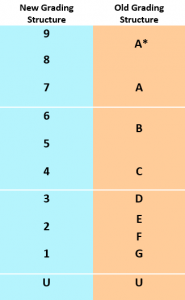This week thousands of students have collected their GCSE results, however many employers are still confused by the new numerical grading system. Research that was commissioned by Ofqual in 2018 found that more than one in five employers wrongly believed that 1 was the top grade. Those in higher education such as Graduates are also still affected.
The A* to G grading system has been replaced with a 9 to 1 system, with 9 being the highest grade. The new grading system has been implemented to better differentiate between students of different abilities. A grade 4 now represents a grade C and there are now more grades above a grade 4. This means there is a greater differentiation for the top levels. The qualifications are also more challenging to ensure students are better prepared for further education such as University or the world of work.
It is important to understand that the new grading system cannot be directly compared to the old grades. There are certain places in which they can be aligned which is shown in the table below.
Key Information
-
- A grade 9 is the highest grade available and will be awarded to fewer students than the previous grade of an A*.
- The bottom of a grade 7 is the equivalent to the bottom of the old grade A.
- The bottom of a grade 4 is the equivalent to the bottom of the old grade C.
- The bottom of a grade 1 is the equivalent to the bottom of the old grade G.
- Grades 4 and 5 equate to a pass mark. A grade 4 represents a standard pass and a grade 5 represents a strong pass.
- A grade U still represents an ungraded exam meaning sufficient marks were not achieved.
What does this mean for you as an employer? If your previous entry requirement was a grade C it is now reasonable to ask for at least a grade 4. Furthermore, Grades 7, 8 and 9 are all fantastic grades which correspond to the previous grades A* and A. A grade 9 will be awarded to students that have performed exceptionally and a grade 8 is positioned between an A* and an A.
Think you understand all of that? Well the grading system has been introduced since 2017 when it was first used to grade Maths, English Language and Literature. In 2018, a further 20 subjects were phased in and finally in 2019 a further 25. This means that by the summer of 2020 all GCSE will have the numerical grading system. This is summarised in the table below.
This raises the question whether in the short-term students should clarify what their grades mean to avoid confusion. As employers, if you are confused by what the numerical grades represent just ask the candidate to explain. Don’t miss out on great candidates because you are unsure what their grades mean!

Looking to find out more about higher education?
Check out our new blog on – Understanding the new changes to B-TECs and what are T-Levels? – A Guide for Graduate Employers